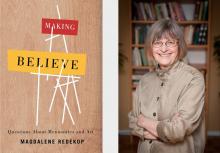Ancient cave drawings illustrate that artistic expression is endemic to humanity. And throughout history, artists have pushed boundaries and come into conflict with their communities.
Mennonites exemplify this tension as much as or more than most communities, due to their emphasis on rules and ethics and a more literal interpretation of the biblical text. Mennonite artists have often faced ostracism for following their imagination.
Magdalene Redekop, professor emerita of English at the University of Toronto, is a literary critic who grew up in a conservative Mennonite community in Manitoba. In Making Believe: Questions About Mennonites and Art, she argues that “art provides a space where we can deal with the crisis of representation by making believe together and by participating in dialogue.”
Redekop explores a renaissance of Mennonite literary output in the 1980s and ’90s, starting in Manitoba, part of a blossoming of Canadian literature. These “secular Mennonites” joined other cultural groups in developing their own literature.
The book’s subtitle is appropriately humble, emphasizing Redekop’s point that “only dialogue brings art to life.” Rather than offering definite answers to identity and representation, the book asks questions and invites readers to dialogue with artists and each other about the meaning and impact of art. She quotes one writer who says that “if there is a Mennonite inflection or accent” to their art, it is that “they keep asking questions.”
The book is not about “Mennonite art.” Redekop emphasizes that “‘Mennonite’ is not an adjective modifying ‘art.’ It is more like a floating place marker, so porous that it welcomes occupation. We are all part of many overlapping communities that make believe together.”
Redekop addresses Mennonite writers, musicians and visual artists but not those involved in film or dance. She follows a principle of writing that you show the universal through the particular. She looks at specific Mennonite communities and specific artists and their works to draw lessons that may apply more broadly.
Redekop focuses much of her attention on two Mennonite communities in Manitoba: the Kanadier, who came as immigrants in the 1870s, and the Russländer, who came as refugees in the 1920s. She grew up in the former, speaking Low German, while many of the literary artists who gained attention later were Russländer.
At the same time, she recognizes the complexity of Mennonite identity, noting the Mennonite churches in Africa, Asia and Latin America. However, she writes, “these converts, though vastly outnumbering North American Mennonites, have not, for the most part, engaged with the cultural and ethnic conflicts that are part of the flowering of art on this continent.” She also understands that both of these Manitoba Mennonite communities are part of a settler culture.
Like many Mennonites, these have struggled with nostalgia, a refusal to deal with current issues of life. One of the tasks of artists is to resist nostalgia and offer critique of tradition.
Redekop is an astute critic, offering close observations of various works. I was especially drawn to her reading of fiction writers, though she also addresses poetry, music and visual art.
The focus on these relatively small communities will appeal to some readers who share that background, while others may find it wearisome. As one who did not grow up in a Mennonite community, I still found her observations interesting. And while I don’t share her background, her book helped me reflect on my own interaction with art — mostly fiction, plus music and film, mostly from secular sources.
Redekop wisely combines memoir with her criticism, which helps contextualize her observations. Her occasional academic language will turn off some readers, but I was moved by the sections where she shared her own experiences, such as her response to the music played at her husband’s funeral.
Making Believe encourages readers to engage art by Mennonites — using a broad understanding of that designation — and dialogue with it, especially when it disturbs us.
Art invites us to a place of unknowingness, which helps us encounter grace, a challenge for Mennonites, who tend toward action. Two of the scariest words I hear from religious people are, “I’m sure.” Art asks us to question ourselves and our beliefs. Redekop’s book is a tool for navigating those questions.
Gordon Houser retired in September as editor of The Mennonite. This article originally appeared in Anabaptist World.
Related stories:
Fall 2020 List of Books & Resources
‘The Daily Bonnet’ creator publishes book
Pastor channels love of stories into children’s books

Magdalene Redekop (right), a professor emerita of English at the University of Toronto who grew up in a conservative Mennonite community in Manitoba, argues in her new book that 'art provides a space where we can deal with the crisis of representation by making believe together and by participating in dialogue.'



Add new comment
Canadian Mennonite invites comments and encourages constructive discussion about our content. Actual full names (first and last) are required. Comments are moderated and may be edited. They will not appear online until approved and will be posted during business hours. Some comments may be reproduced in print.